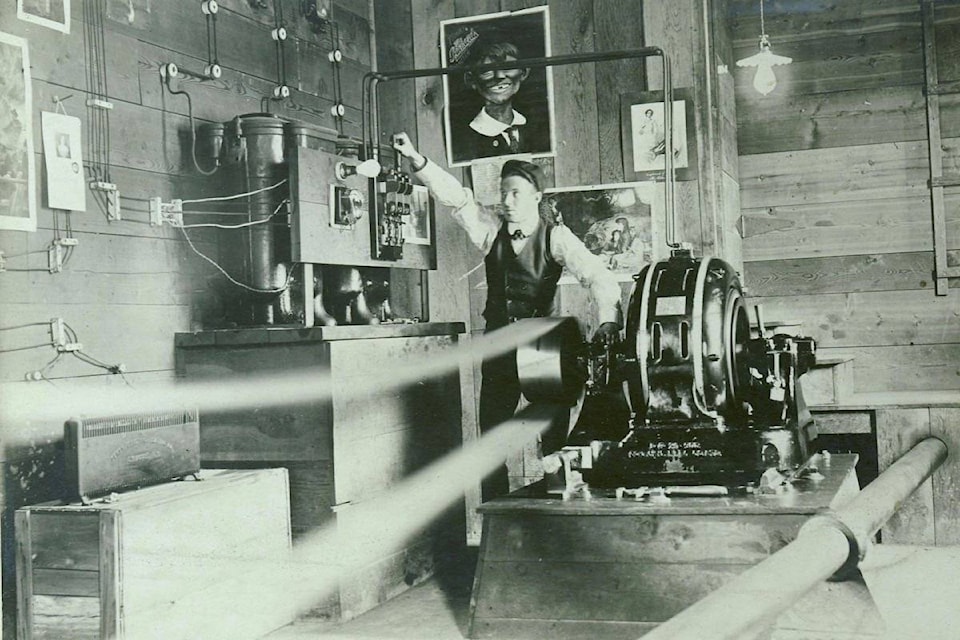When a consortium decided to bring water and electricity to Ashcroft in 1897, they wasted little time raising funds and starting work on the necessary infrastructure. They chose a spot on the Bonaparte River about two miles from Ashcroft, where the river narrowed as it ran through a steep-sided gorge.
Then as now it is an inaccessible spot. Recent work at the nearby fish ladder on the Bonaparte, downstream from where the powerhouse and dam were located, necessitated digging out a road before work could start, and the site chosen for the water and power project was even more difficult to get men and materials to. However, work proceeded throughout 1898, with the Journal reporting on developments.
In order to supply power to the town, a dam needed to be built, ultimately requiring nearly 400,000 feet of timber and more than 20,000 iron bolts. When it was completed, the dam was some 200 feet long across the stream on top, and about 100 feet long at the base. By filling the area above and below the dam with thousands of tons of rock, a total fall of about 42 feet was achieved, which could be increased if needed.
A powerhouse was built on the south side of the river. About 50 x 50 feet, the two-storey structure was built of heavy timbers and housed an electric generator and a rotary irrigation pump. Two 30-inch turbine power wheels on a 36-foot-long steel shaft generated about 800hp via a three-phase system, with the electricity carried by copper wires to a pumphouse in Ashcroft.
Transformers reduced the voltage to run an electric motor for the water pump, which forced water through a six-inch steel main to a 60,000-gallon water tank overlooking the town. The water was then distributed through pipes — at 87 pounds of pressure — to the houses and businesses in Ashcroft.
A steady and reliable water system was also a boon for the newly-constructed Ashcroft fire hall, which had been completed in February 1898. In October 1898 — just as the water and electricity systems were being completed — a quantity of fire apparatus was purchased for the town, including fire hoses, nozzles, and a hose reel (total cost: $982.50, including freight). A system of fire hydrants had been placed around the town, and a fire brigade had been organized, giving Ashcroft “as good fire protection as any town in this or any other country”.
It was not just the town of Ashcroft that would benefit from the new water supply. Flumes had been built from the powerhouse on the Bonaparte west to Boston Flats, where the water and electric consortium had purchased land for the purpose of growing crops. The company also proposed a sawmill on the Bonaparte, to be located near the powerhouse, with logs rafted down the river to the site.
As if water and electricity were not novel enough, the company also installed a telephone line — Ashcroft’s first — between the powerhouse on the Bonaparte and the pumphouse in town. “Within a few seconds at any time the pumps could be started to augment the supply of water in the tank in case of serious fire.”
A brief test of the electric system was carried out in early September 1898, and Ashcroft got its first glimpse of a brave new world illuminated by electric lights. Candles and coal oil — messy, smelly, and potentially dangerous in a hot and dry town where everything was built of wood — were the main sources of light, and the sight of electric lights twinkling in the darkness must have been akin to magic.
“The lights shone up brilliantly in the town,” reported the Journal, which noted that it would be about a month before the water and electric systems became permanent. Work continued through September, connecting the systems to houses and businesses and laying a water main down Railway Avenue.
On Oct. 6, 1898 the big day arrived, and the electrical system was switched on. “For the first time Ashcroft enjoyed thoroughly the novel sight of having the streets in part and such of the houses as were ready lighted by electricity. The light was thoroughly satisfactory and to say Ashcroft is pleased with its system is putting the case very mildly,” noted the Journal in its Oct. 8 edition, adding that an upcoming issue of the paper would be devoted to the subject.
“For this issue we will only add that Ashcroft has one of the best, if not the best water and light systems in British Columbia and that we are all rejoiced thereat.”
Next time: “We shall be more than satisfied with these, our modern improvements.”
editorial@accjournal.ca
Like us on Facebook and follow us on Twitter
